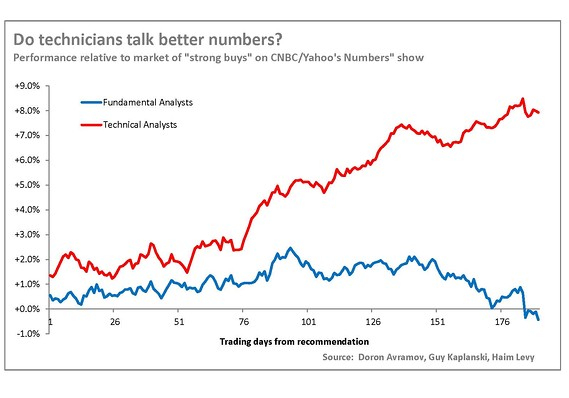By Elliott Wave International
Editor’s note: You’ll find the text version of the story below the video.
Technical versus fundamental analysis: Which approach yields better investment results?
A new study by three finance professors offers an answer.
The focus of their study were a thousand pairs of recommendations made between November 2011 and December 2014 on the TV show “Talking Numbers” … The first half of each pair was a recommendation from a top technician about a stock in the news; the second half was a recommendation about that same stock from a leading fundamental analyst. [Marketwatch, Sept. 4]
This chart shows the results:
In the nine months following each recommendation, the stocks technical analysts identified as strong buys on average outperformed the broad stock market by 7.9%. The stocks they mentioned as strong sells underperformed by 8.9%.
By contrast, the strong buy recommendations from fundamental analysts underperformed the overall market during the same timeframe. More than that, the fundamental analysts’ strong sell recommendations performed closely to their strong buys.
Technical analysts were the clear winners.
Elliott wave analysis of financial markets is a specific form of technical analysis.
Our subscribers have recently been well served by the Elliott wave method and other technical indicators. Consider this commentary from the August 19 Financial Forecast Short Term Update:
The decline from yesterday’s highs — 17,568.40 in the Dow and 2103.46 in the S&P — is impulsive (i.e., five waves) … The impulse wave down indicates that the next larger-degree of trend is down. … The weakening internal measures of breadth, volume and momentum are bearish.
… Nearly every index declined in unison, each breaking their respective lows from Wednesday morning’s weak open. … At today’s intraday lows, there were more than five stocks down for every one up on the NYSE. The up/down volume ratio was lopsidedly bearish too. … The closing a/d was 0.33:1, with three stocks down for every one up. Down volume on the Big Board was 81% of up plus down volume. … When will selling pressure again materialize to drive prices significantly lower? The answer is that it’s starting to materialize now.
The S&P 500 gapped lower at the open during the next two trading sessions (August 20-21).
On August 24, the intraday low for the S&P 500 was 1867.01 — down nearly 13% from its May 20 peak. The Dow’s intraday low was 15,370.30 — down 16.4% from its May 19 peak.
After the Labor Day weekend (Sept. 8), stocks traded well above those lows.
But beware: The Elliott wave model and other technical indicators suggest that more market turmoil is ahead.
Technicians tend to rise in prominence in bear markets, and they appear poised to do so again.
Video Crash Course
|
This article was syndicated by Elliott Wave International and was originally published under the headline Stock Market Forecasts: Why You Should Consider Technical Analysis. EWI is the world’s largest market forecasting firm. Its staff of full-time analysts led by Chartered Market Technician Robert Prechter provides 24-hour-a-day market analysis to institutional and private investors around the world.

Speak Your Mind